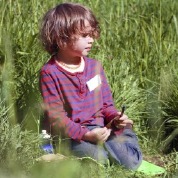 In my previous blog about our Nature Play: Nature Conservation project I explained some of the things we found out from observing children taking part in unstructured play sessions in a wild corner of the Demonstration Garden in the Royal Botanic Garden Edinburgh. Last week I presented these findings at the International Botanic Garden Education Congress at Missouri Botanic Garden which gave me the opportunity to reflect on why we did this work. I also want to a provide link below to the report and show film that we have produced.
In my previous blog about our Nature Play: Nature Conservation project I explained some of the things we found out from observing children taking part in unstructured play sessions in a wild corner of the Demonstration Garden in the Royal Botanic Garden Edinburgh. Last week I presented these findings at the International Botanic Garden Education Congress at Missouri Botanic Garden which gave me the opportunity to reflect on why we did this work. I also want to a provide link below to the report and show film that we have produced.
Play has an important role in human development, just as it does in many other animal species. There is also evidence that open-ended and unstructured play we encouraged during the Nature Play project, in particular, stimulates children’s curiosity and imagination and develops their creativity. Patrick Bateson and Paul Martin in their book on Play, Playfulness, Creativity and Innovation point out that many great artists and Nobel laureates, including Pablo Picasso and Alexander Fleming, had a playful and exploratory approach to life continued into adulthood.
Play is important to stimulate developing minds but is tactile and emmersive ‘free play’ in a natural environment any better at fostering creativity than virtual games like Minecraft? Widespread use of computer games has now been around long enough for the evidence to have accumulated. Surveys in various westernised countries have shown individuals and institutions are realising just how much we have lost in the way of opportunities for nature play. Botanic gardens, especially those in urban locations, will find themselves under increased pressure to provide room for safe unstructured play on their sites. The session on unstructured play at the Missouri Education Congress proved a popular choice with delegates and the RBGE’s Calouste Gulbenkian Foundation-funded research project got its first public airing at this meeting.
 The report is available here: Nature Play Final Report. The short film above summarises the findings.
The report is available here: Nature Play Final Report. The short film above summarises the findings.
The research was carried out by Clare Nugent and the film-maker was Sabine Hellmann. Jaimie Macdonald and Sarah Hutcheon were also part of the Nature Play team.
The response from the parents and children who took part has been overwhelmingly positive. It will be interesting to see how the botanic garden and nature conservation world respond. Meanwhile we would welcome any comments or ideas for developing this work. Contact me at: i.edwards@rbge.org.uk
